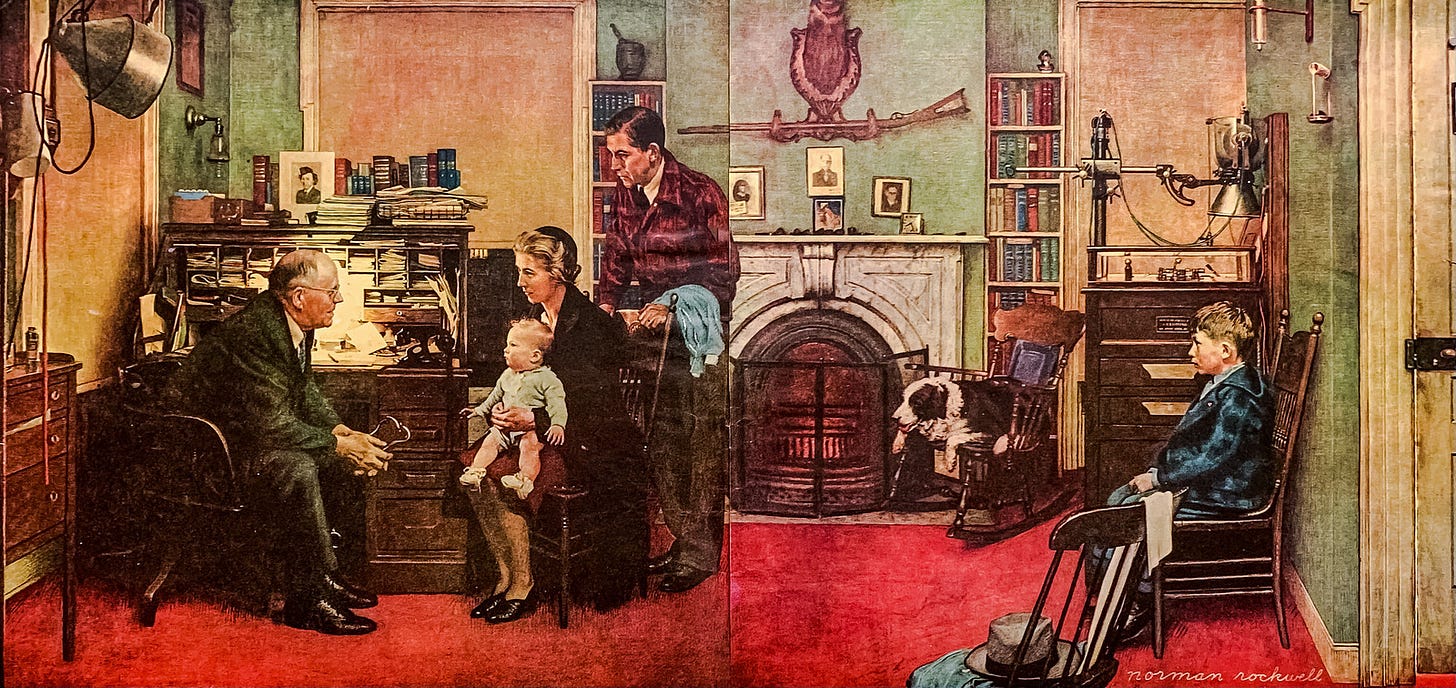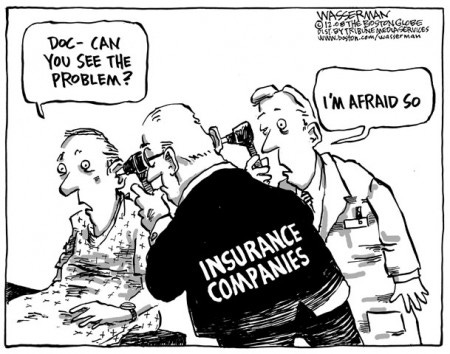The Alternative Healthcare Model is the Original One
Calling all doctors and patients to rebuild the healthcare landscape
Doctors usually make good money in exchange for working way too much, while paradoxically spending way too little time with each patient.
They’re pinched more and more every year by declining reimbursements from insurance companies, so they have to see more patients in the same amount of time.
They also have to document visits in excruciating detail and are enslaved to their electronic medical records (EMRs) - which is why you almost never catch the eye of an insurance doc, they are so busy typing everything while talking to you.
What you see in the visit is just the tip of the iceberg.
They have more typing and arranging and clicking demanded by the bossy EMR outside the room before and after your visit.
They also aren’t incentivized properly because the wrong person is paying them. You pay for health insurance and maybe a small copay visit fee, but most of their compensation comes to them via insurance, the middleman, so they are beholden to the insurance companies which are in bed with Big Harm-a (not misspelled).
So Big Harm-a ultimately dictates what doctors can and can’t do, and via the insurance reimbursements dangles the most tempting bait if the government decides it’s time for something like mRNA shots all around.
Almost all doctors are trapped in a vise that’s gradually tightening, but they don’t have to be.
Most think there’s no easy way out, because they’ve never done the math on the rapidly growing alternative practice model.
THE LIFELINE
Most primary care physicians working with insurance have thousands of patients.
A 2012 study published in the Annals of Family Medicine estimated that the average PCP has a panel of 2300 patients, and went on to note that:
“Estimates suggest that a primary care physician would spend 21.7 hours per day to provide all recommended acute, chronic, and preventive care for a panel of 2,500 patients.”
I have met many doctors with busy mature practices with panels of 5000 patients and above.
On the other hand, cash pay direct primary care (DPC) docs have far fewer patients, often numbering in the low to mid hundreds depending on how much they charge (usual range is anywhere from $100-$500/month and can be higher for more specialized, exclusive or concierge level services).
Even a low end DPC doc charging $100/month will clear the same or more than a typical insurance practice with just a few hundred patients (ie as little as 1/10th the patient panel).
500 patients at $100/month = $50,000/month = $600,000/year.
Minus typical practice overhead of 50% = $300,000/year take home.
(And overhead could go even lower in DPC due to no need for back office staff hired just to pester insurance companies to pay what they owe.)
Depending on who you ask, the average PCP salary in the US is now somewhere between $200k and $260k per year, so $300k would be a really good, above market salary for an insurance doctor carrying a mid range 2300 patient panel, and all the PCPs on the wrong end of the bell curve make a lot less (while doing way more work).
Any reasonably agreeable, likable doctor with thousands of preexisting insurance patients can easily transition to hundreds willing to pay monthly out of pocket to stay in their practice and get a lot more personal time and attention.
And a doctor just starting out only needs to convince a few hundred patients to join his practice.
Until they are up and running they can moonlight weekends at a local hospital to get by.
For the best advertising/outreach they could just whip up a convincing presentation and go deliver it for free at nursing homes, schools and churches (or just copy one they find from someone else as a start and then make it their own).
Hand out flyers with a number and link to a simple signup page with more free stuff, like a short video or ebook about simple changes to help finally resolve chronic health issues, optimize health or taper off chronic meds.
The pitch is simple.
You don’t need any more proof than your own experience to know that primary care is broken in the US.
Of course there’s also plenty of data to support it. For example one study noted that “only 8% of US adults aged 35 years or older received all recommended, high-priority, appropriate clinical preventive services.” (Mechley, 2021)
In any endeavor outcomes matter, but they are especially important in medicine.
In the US 42% of people now have 2 or more chronic health conditions, and the rates are skyrocketing at the same time that healthcare utilization is shooting up. The more prescriptions and procedures we get, the more disease we have.
On the other hand studies show that patients in DPC have better health, including fewer hospital stays, better blood pressures, and improved diabetes care.
It stands to reason that if we cut out the middlemen and pay doctors the way we pay lawyers and plumbers, societal and personal health care costs would plummet because doctors would be incentivized to actually keep you healthy and out of the hospital and have the time to convince you to do what it takes to achieve the best health outcomes.
LEAVE NO MAN BEHIND
Along the way there are some easy solutions for privatizing health coverage for those who can’t afford it.
It’s estimate that between 6 and 16% of Americans already have some form of DPC or concierge physician and that 8-16% of doctors are currently planning to transition to some form of cash based practice outside the mainstream insurance model.
So where does that leave the rest of the country? Inflation is making it harder than ever for people to make ends meet, and it’s difficult to find a spare $100/month in most households.
We don’t need to reinvent the wheel.
What we used to do to solve this problem wasn’t rely on big government, but for those who could afford it to donate money to groups like churches that built health care systems that treated people for free.
Those same non profit systems do still exist in many cities, but have been warped by their interactions with insurance companies.
We need to starve the insurance companies out of existence and transition to local communities supporting themselves again. In order to help cover expensive procedures, people who can afford to pay in to a plan monthly, can choose to join existing nonprofit health sharing co-ops that provide coverage similar to insurance at a much lower cost.
Physicians should also normalize a culture of pro bono work the way lawyers have. They can provide premium concierge tier services for wealthy clients and a regular DPC tier for those who do have enough money, and another pro bono tier for those who don’t.
I’ve written about my desire to start an online PCP service before and I’m still looking for a doctor who’s aligned with my own philosophy to help me launch it for mygotodoc.
I’m also looking into how we can branch out and efficiently find new patients in a hybrid local telemedicine model. If any of you are physicians, NPs or PAs and are interested in starting your own local DPC/concierge style practice maybe we can help you market and launch it.
AN INSATIABLE APPETITE
Healthcare is the single biggest industry in the US today and like any capitalistic endeavor in a debt driven inflationary economy, it can only get bigger fast or die trying.
This is a deeper topic, for another day, but you can see this post in the meantime that helps explain why that is:
In order to grow at the current pace, “healthcare” actually needs to be disease care.
If everyone who came in for a consult left without their illness, the whole industry would collapse and the bankers wouldn’t get paid back on the loans that keep it all afloat and growing.
The trifecta of Big Ag, Big Chemical and Big Harm-a create a perfect storm of ever spreading disease.
In the eye of that storm, there’s a welcoming casino where the doors are always open, that goes by the name of Medical Insurance.
But medical insurance is far worse than simple gambling.
Even though many people do get big payouts, the house always wins because disease is what’s incentivized, not health.
In a casino they comp the room, in the insurance biz you get comped for bad care year in and year out that breeds disease.
The only way to get rid of the super-sized insurance parasite, is to starve it to death by choosing an alternative system, to flee the roach motel while you still can.
It will start small, but grow by leaps and bounds once people start to see others doing it more and more and then they too will jump ship.
It seems like a difficult and dangerous leap, but it really isn’t.
If doctors think it through and focus on the very reasonable numbers required to make it work it will be a lot more manageable and if patients prioritize their health and take a hard look at their finances, many may be able to swing it until there are more options that help the less fortunate pay for real healthcare rather than disease management.
In the meantime it is possible to simply take radical responsibility for your health and get well without a doctor. You will find many people on social media who have done it and are more than happy to coach you to do it too.
At least 90% of health, if not more, is really in your hands and is as simple as making different lifestyle choices: get motivated, increase emotional intimacy and time spent with family and friends without technology, improve emotional health with a gratitude practice, turn off the lights and screens at sunset, sleep early and deeply, wake early, work early rather than late, get direct sun throughout the day and spend as much time outdoors as possible, take walks, sweat a little, eat real, slow food made at home from scratch, avoid vegetable oils, get rid of chemicals from your home, invest in a simple and cheap air purifier (you can even DIY them for 20 bucks, or if you can swing it, a more fancy one like Molekule), etc.
Sounds like a lot, but take it slow, take baby steps, and it will be easy.







I left my pcp of 30 yrs two years ago when she tried to talk me into a Covid and flu shot after she knew I had already had covid and natural immunity and never took flu shots. I was already paying to see a naturopath for my hormones and thyroid so I have turned all my care over to her. Insurance still covers my labs and tests. No regrets.
Yes yes yes! I’m an RN whose eyes really got opened during the plandemic and decided to leave the unethical employers who want to use me. Now that there is so much distrust of hospitals and their killing protocols for covid and God knows what else, I see the silver lining - a new model emerging - a wholistic one - where we are empowered to heal in the way our bodies are designed. Dr Haider you are truly inspiring in this movement towards real health. I learn so much everytime I open your substack. Thank you so much! And nurses out there - I encourage you to explore functional medicine training and seek out these physicians and nursing organizations who want to make real changes in healthcare(Remnant Nursing, Kim Overton’s, BSN, RN organization for example).